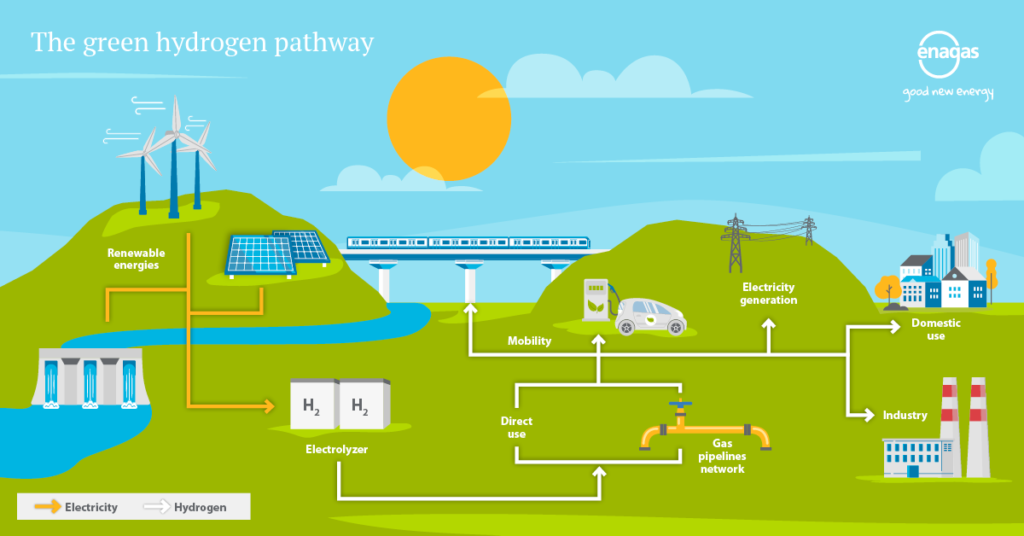9 April, 2021
- Green hydrogen is a 100% clean energy that has a great many advantages and applications.
- It plays an important role in sectors that are difficult to electrify, contributing to their decarbonisation.
Hydrogen is the most abundant element present in the Universe, it is found combined with other elements and constitutes approximately 75% of its total material.
Hydrogen is mainly used by the chemical and refining industries, and global demand in 2019 amounted to 70 million tonnes, according to the International Energy Agency. Most of this hydrogen is known as grey hydrogen, which is produced by the steam reforming of natural gas. This process produces CO2, which means it is not an emission-free process.
With a view to a decarbonised economy, the type on which most expectations are being placed is green hydrogen, which is obtained from renewable sources, such as solar or wind, and mainly through the electrolysis of water.
One of its most outstanding advantages is that it is a 100% clean energy, with zero CO2 emissions in its production – only water vapour is emitted. Moreover, it has multiple applications as an energy source across all sectors, even those where electrification is difficult, such as heavy transport and intensive industry. It also contributes to managing renewable energies, as well as to the transport and storage of energy.
With a view to a decarbonised economy, the type on which most expectations are being placed is green hydrogen
Green hydrogen applications
Green hydrogen can be used directly or injected into the gas grid. In the latter case, thanks to its ability to be stored and transported, it can be produced at one place and at one time and used at another place at a later date, resulting in the decoupling of the production and consumption processes.

The main applications for green hydrogen include:
- Industry. Industry currently accounts for more than 90% of global hydrogen consumption, but mainly involving grey hydrogen, i.e. hydrogen that is not CO2-free. Using green hydrogen in these processes would be a very important step to minimising the environmental footprint of industry. In Europe alone, the use of green hydrogen could prevent the emissions of approximately 560 million tonnes of greenhouse gas emissions by 2050, generating annual revenues of some 820 billion euros, reducing local emissions (NOx) in road transport by around 15% and creating up to 5.4 million jobs, according The Fuel Cells and Hydrogen Joint Undertaking (FCH JU).
–
- Transport. Another of the sectors in which renewable gases – hydrogen, specifically – will be fundamental is mobility. Many projects are currently focused on developing hydrogen-powered vehicles of all types: aviation, fuel cell electric vehicles, rail and maritime transport. The use of renewable gases for mobility will bring about the decarbonisation of one of the sectors that emits the most CO2 emissions and has the greatest impact on air quality in our cities. Between 10 and 15 million cars are expected to run on green hydrogen by 2030. However, its use goes beyond light vehicles, as it will be essential for the decarbonisation of heavy transport and rail and maritime transport, sectors where electrification is not a technically feasible solution at present.
–
- Domestic uses. This renewable gas is suitable for domestic and commercial consumption. Its main advantage lies in its ability to be transported and stored using the existing grid, without the need for significant additional network investments. An example of this use is heating systems in residential and commercial environments, where decarbonisation poses a major challenge. The solution as a preliminary step to total decarbonisation could involve the combined use of green hydrogen and natural gas, making efficient use of gas infrastructure. Renewable hydrogen can also be used to generate electricity by means of fuel cells, a totally clean process that can produce domestic hot water.
–
- Electricity generation. By taking advantage of excess renewable electricity generation during peak hours, green hydrogen can be destined to electricity generation and fed into the grid during off-peak hours.
–
A shared commitment to renewable hydrogen
Green hydrogen will be key to achieving climate neutrality and a fully renewable electricity system by 2050. Globally, more than 30 countries have hydrogen roadmaps and more than 200 large-scale hydrogen projects are under development across the value chain, 85% of which are in Europe, Asia and Australia.
A large number of energy companies are working on specific green hydrogen development projects
Over the next ten years, Europe is expected to allocate up to 30 billion euros on the roll-out of this technology.
In the case of Spain, our country has the most ambitious renewable electric energy development plan in the EU, the PNIEC, and a hydrogen roadmap. Spain also has the support of industry, as well as a large number of energy companies working on specific green hydrogen development projects.
